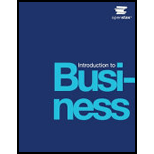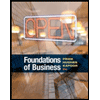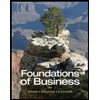
Introduction to Business
OER 2018 Edition
ISBN: 9781947172548
Author: OpenStax
Publisher: OpenStax College
expand_more
expand_more
format_list_bulleted
Textbook Question
Chapter 4.2, Problem 1CC
How does a
Expert Solution & Answer
Want to see the full answer?
Check out a sample textbook solution
Students have asked these similar questions
Right Answer
Provide answer this financial accounting question answer will be accurate and step by step calculation
Moose Enterprises finds it is necessary to determine its marginal cost of capital. Moose’s current capital structure calls for 50 percent debt, 30 percent preferred stock, and 20 percent common equity. Initially, common equity will be in the form of retained earnings (Ke) and then new common stock (Kn). The costs of the various sources of financing are as follows: debt, 9.6 percent; preferred stock, 9 percent; retained earnings, 10 percent; and new common stock, 11.2 percent. a. What is the initial weighted average cost of capital? (Include debt, preferred stock, and common equity in the form of retained earnings, Ke.) b. If the firm has $18 million in retained earnings, at what size capital structure will the firm run out of retained earnings? c. What will the marginal cost of capital be immediately after that point? (Equity will remain at 20 percent of the capital structure, but will all be in the form of new common stock, Kn.) d. The 9.6 percent cost of debt referred to earlier…
Chapter 4 Solutions
Introduction to Business
Ch. 4.1 - What is a sole proprietorship?Ch. 4.1 - Why is this a popular form of business...Ch. 4.1 - What are the drawbacks to being a sole proprietor?Ch. 4.2 - How does a partnership differ from a sole...Ch. 4.2 - Describe the four main types of partnerships, and...Ch. 4.2 - What are the main advantages and disadvantages of...Ch. 4.3 - What is a corporation? Describe how corporations...Ch. 4.3 - Summarize the advantages and disadvantages of...Ch. 4.3 - Why do S corporations and limited liability...Ch. 4.4 - Describe the two types of cooperatives and the...
Ch. 4.4 - What are the benefits of joint ventures?Ch. 4.5 - Describe franchising and the main parties to the...Ch. 4.5 - Summarize the major advantages and disadvantages...Ch. 4.5 - Why has franchising proved so popular?Ch. 4.6 - Differentiate between a merger and an acquisition.Ch. 4.6 - What are the most common motives for corporate...Ch. 4.6 - Describe the different types of corporate mergers.Ch. 4.7 - What are some of the demographic trends currently...Ch. 4.7 - As a prospective business owner, what could you do...Ch. 4.7 - What other economic trends are influencing today's...Ch. 4 - After seeing a Quiznos franchise recruitment...Ch. 4 - Is the not-for-profit form of business...Ch. 4 - Why has this form of ownership not been replicated...Ch. 4 - What are the limitations and constraints that this...
Additional Business Textbook Solutions
Find more solutions based on key concepts
1.10 Brown’s, a local bakery, is worried about increased costs—particularly energy. Last year’s records can pro...
Operations Management
Small Business Analysis Purpose: To help you understand the importance of cash flows in the operation of a smal...
Financial Accounting, Student Value Edition (5th Edition)
E6-14 Using accounting vocabulary
Learning Objective 1, 2
Match the accounting terms with the corresponding d...
Horngren's Accounting (12th Edition)
Comparison of projects using Net Present Value. Reasons for the conflicts in ranking using Net Present Value an...
Gitman: Principl Manageri Finance_15 (15th Edition) (What's New in Finance)
The reason behind the expected return of a risky security that generally differs from the risk-free interest ra...
Corporate Finance (4th Edition) (Pearson Series in Finance) - Standalone book
(Record inventory transactions in the periodic system) Wexton Technologies began the year with inventory of 560...
Financial Accounting (12th Edition) (What's New in Accounting)
Knowledge Booster
Similar questions
- 7. Berkeley Farms wants to determine the minimum cost of capital point for the firm. Assume it is considering the following financial plans: Cost (aftertax) Weights Plan A Debt .................................. 4.0% 30% Preferred stock .................. 8.0 15 Common equity ................. 12.0 55 Plan B Debt .................................. 4.5% 40% Preferred stock .................. 8.5 15 Common equity ................. 13.0 45 Plan C Debt .................................. 5.0% 45% Preferred stock .................. 18.7 15 Common equity ................. 12.8 40 Plan D Debt .................................. 12.0% 50% Preferred stock .................. 19.2 15 Common equity ................. 14.5 35 a. Which of the four plans has the lowest weighted average cost of capital? Use the Kd (cost of debt) = Y(1 - T), Kp (Cost of preferred stock) = Dp/Pp - F, Ke = D1/P0 + g formulas or I will not understand.arrow_forwardCompute the net incremental cost or savings of buying thearrow_forwardNeed help with this accounting question not use ai please don'tarrow_forward
- What would be the value of the ending inventory?arrow_forwardPlease solve this question Financial accounting and step by step explanationarrow_forwardNeed use the Kd (cost of debt) = Y(1 - T), Kp (Cost of preferred stock) = Dp/Pp - F, Ke = D1/P0 + g formulas or I will not understand. Delta Corporation has the following capital structure: Cost Weighted (after-tax) Weights Cost Debt 8.1% 35% 2.84% Preferred stock (Kp) 9.6 5 .48 Common equity (Ke) (retained earnings) 10.1 60 6.06 Weighted average cost of capital (Ka) 9.38% a. If the firm has $18…arrow_forward
arrow_back_ios
SEE MORE QUESTIONS
arrow_forward_ios
Recommended textbooks for you
 Foundations of Business (MindTap Course List)MarketingISBN:9781337386920Author:William M. Pride, Robert J. Hughes, Jack R. KapoorPublisher:Cengage Learning
Foundations of Business (MindTap Course List)MarketingISBN:9781337386920Author:William M. Pride, Robert J. Hughes, Jack R. KapoorPublisher:Cengage Learning Foundations of Business - Standalone book (MindTa...MarketingISBN:9781285193946Author:William M. Pride, Robert J. Hughes, Jack R. KapoorPublisher:Cengage Learning
Foundations of Business - Standalone book (MindTa...MarketingISBN:9781285193946Author:William M. Pride, Robert J. Hughes, Jack R. KapoorPublisher:Cengage Learning Management, Loose-Leaf VersionManagementISBN:9781305969308Author:Richard L. DaftPublisher:South-Western College Pub
Management, Loose-Leaf VersionManagementISBN:9781305969308Author:Richard L. DaftPublisher:South-Western College Pub

Foundations of Business (MindTap Course List)
Marketing
ISBN:9781337386920
Author:William M. Pride, Robert J. Hughes, Jack R. Kapoor
Publisher:Cengage Learning

Foundations of Business - Standalone book (MindTa...
Marketing
ISBN:9781285193946
Author:William M. Pride, Robert J. Hughes, Jack R. Kapoor
Publisher:Cengage Learning

Management, Loose-Leaf Version
Management
ISBN:9781305969308
Author:Richard L. Daft
Publisher:South-Western College Pub
